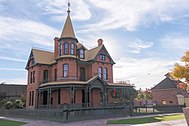Electrician in Cornville
Electrician Cornville
When choosing an electrician, remember that they'll be charging for their time. Make sure you ask any questions you may have before you hire them. Find out how much space they'll need to access, and whether they require a meter clearing for them to work. A good inspector should be able to give you a clear picture of the wiring in your home and your electrical system's safety.

Electricians Cornville
You can ask for references and reviews to help you decide the price of an electrician. It is important to find someone with the right skills and experience to fulfill your needs if you're on a budget. You should prioritize license and experience over price. It is better to hire a master-level or journeyman electrician with thousands of hours. The more professional and skilled an electrician is, the better your chances of receiving quality work.
Electrician in Cornville
Another way to find a reliable electrician is to check online reviews. While this isn't always possible, it is a better way to determine which electrician has excellent reviews. In addition to reading reviews, you can also ask your friends and family for referrals. Often, electricians share testimonials with other people who have hired them in the past. If you're unable to find any references, you can ask for them on social media or ask around your neighborhood.


Electricians Cornville
An electrical safety inspection is crucial if your home needs to be safe. The potential for danger can be serious. If an overload occurs, it can lead to your home overheating. Faulty circuit breakers can also cause appliances or light fixtures to cease working and flicker. Electric meters can become faulty over time. An electrical safety inspection by an electrician can help to avoid these problems.
Cornville Electrician
An electrician's work environment will vary depending on what type of work they do. An electrician might have to work in tight spaces, lift heavy objects and may be exposed to extreme heat and dust. Sometimes, an electrician may have to climb ladders or scaffolding. They may also have to be around power transformers or exposed to high levels of electricity. Safety procedures are essential in both cases.

Electrician Cornville AZ
Here are some tips for getting ready for an electrical inspection. Before the electrician arrives, be sure to make sure that all areas are accessible. Make sure to note any issues with your electrical wiring. To ensure safety, you will get a clear picture from an electrician. The electrician will examine the exterior and interior wiring of your house, aswell as the functionality of every fixture.
Electricians Cornville Arizona
Guarantee the work: Professional electrical contractors should have confidence in their work and will not have a problem giving a written guarantee.
Electrician in Cornville
About Phoenix AZ
Phoenix, Arizona
|
Phoenix, Arizona
|
|
|---|---|
| City of Phoenix | |
|
Clockwise, from the top: Downtown Phoenix, St. Mary's Basilica, Rosson House, Mystery Castle, Camelback Mountain, Arizona State Capitol, Arizona Science Center, Chase Tower, and the Papago Park
|
|
|
|
|
| Nickname(s):
"Valley of the Sun", "The Valley"
|
|

Interactive map of Phoenix
|
|
Coordinates:  33°26′54″N 112°04′26″WCoordinates: 33°26′54″N 112°04′26″WCoordinates:  33°26′54″N 112°04′26″W 33°26′54″N 112°04′26″W |
|
| Country | United States |
| State | Arizona |
| County | Maricopa |
| Settled | 1867 |
| Incorporated | February 25, 1881 |
| Founded by | Jack Swilling |
| Named for | Phoenix, mythical creature |
| Government | |
| • Type | Council-Manager |
| • Body | Phoenix City Council |
| • Mayor | Kate Gallego (D) |
| Area | |
| • State Capital | 519.28 sq mi (1,344.94 km2) |
| • Land | 518.27 sq mi (1,342.30 km2) |
| • Water | 1.02 sq mi (2.63 km2) |
| Elevation | 1,086 ft (331 m) |
| Population
(2020)
|
|
| • State Capital | 1,608,139 |
| • Estimate
(2021)[3]
|
1,624,569 |
| • Rank | 5th in the United States 1st in Arizona |
| • Density | 3,102.92/sq mi (1,198.04/km2) |
| • Metro | 4,845,832 (11th) |
| Demonym | Phoenician |
| Time zone | UTC−07:00 (MST (no DST)) |
| ZIP Codes |
85001–85099
|
| Area codes | |
| FIPS code | 04-55000 |
| GNIS ID(s) | 44784, 2411414 |
| Major airport | Phoenix Sky Harbor International Airport |
| Secondary Airports | Deer Valley Airport Phoenix–Mesa Gateway Airport |
| Interstates | |
| U.S. Highways | |
| State Routes | |
| Public transportation | Valley Metro |
| Website | www |
Phoenix (/ˈfiːnɪks/ FEE-niks; Navajo: Hoozdo; Spanish: Fénix or Fínix,[citation needed] Walapai: Banyà:nyuwá[5]) is the capital and most populous city of the U.S. state of Arizona, with 1,608,139 residents as of 2020.[6] It is the fifth-most populous city in the United States,[7] and one of only two U.S. state capitals with a population of more than one million residents, along with Austin, Texas.[8][9][10]
Phoenix is the anchor of the Phoenix metropolitan area, also known as the Valley of the Sun, which in turn is part of the Salt River Valley. The metropolitan area is the 11th largest by population in the United States, with approximately 4.85 million people as of 2020.[9] Phoenix, the seat of Maricopa County, has the largest area of all cities in Arizona, with an area of 517.9 square miles (1,341 km2), and is also the 11th largest city by area in the United States.[11] It is the largest metropolitan area, both by population and size, of the Arizona Sun Corridor megaregion.
Phoenix was settled in 1867 as an agricultural community near the confluence of the Salt and Gila Rivers and was incorporated as a city in 1881. It became the capital of Arizona Territory in 1889.[12] It is in the northeastern reaches of the Sonoran Desert and has a hot desert climate.[13][14] Despite this, its canal system led to a thriving farming community with the original settlers' crops remaining important parts of the Phoenix economy for decades, such as alfalfa, cotton, citrus, and hay.[15][16] Cotton, cattle, citrus, climate, and copper were known locally as the "Five C's" anchoring Phoenix's economy. These remained the driving forces of the city until after World War II, when high-tech companies began to move into the valley and air conditioning made Phoenix's hot summers more bearable.[17]
The city averaged a four percent annual population growth rate over a 40-year period from the mid-1960s to the mid-2000s.[18] This growth rate slowed during the Great Recession of 2007–09, and has rebounded slowly.[19] Phoenix is the cultural center of the state of Arizona.[20] Phoenix is also majority minority, with 42.6% of its population identifying as Hispanic and 42.5% as "white" in the 2020 census.[21]










